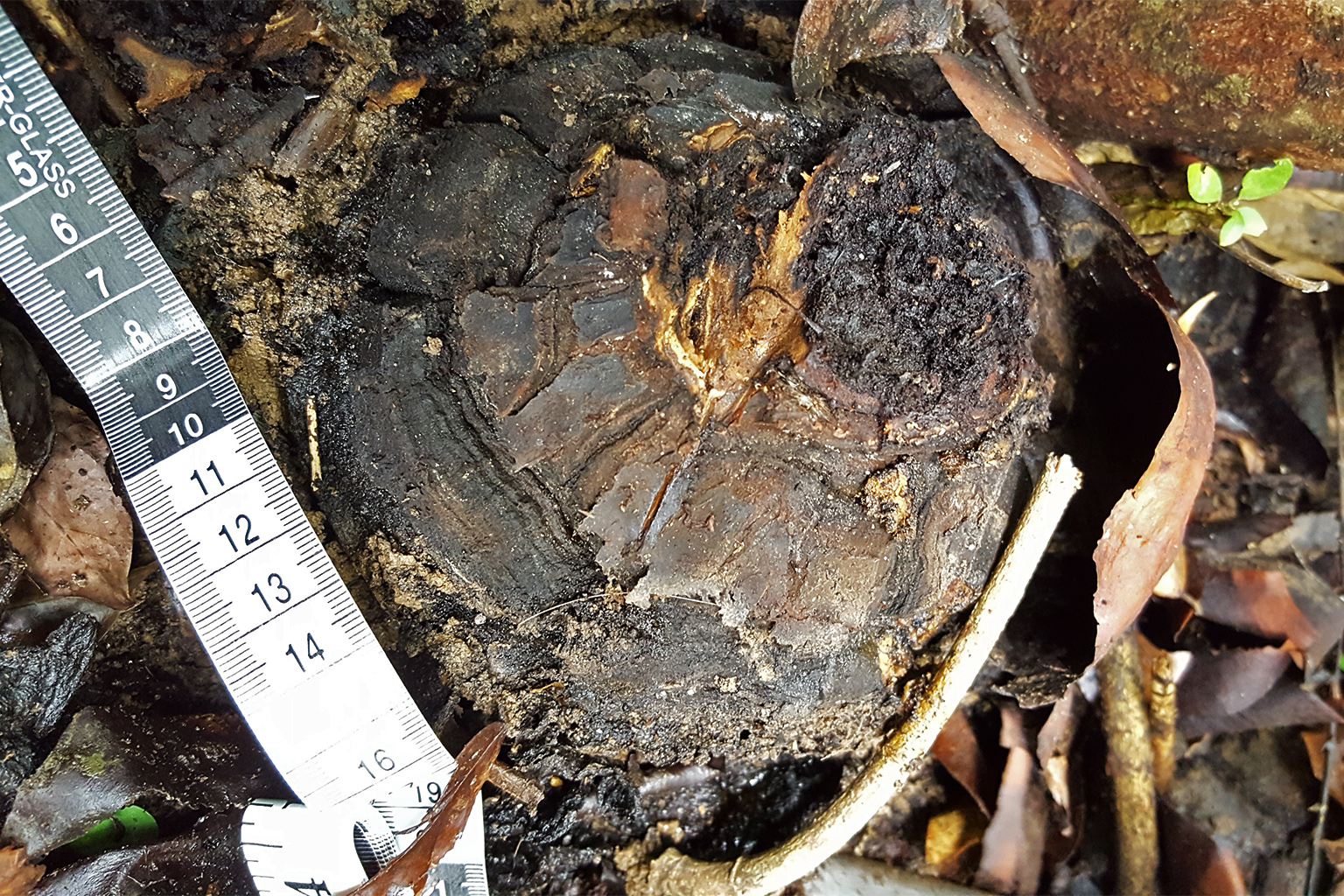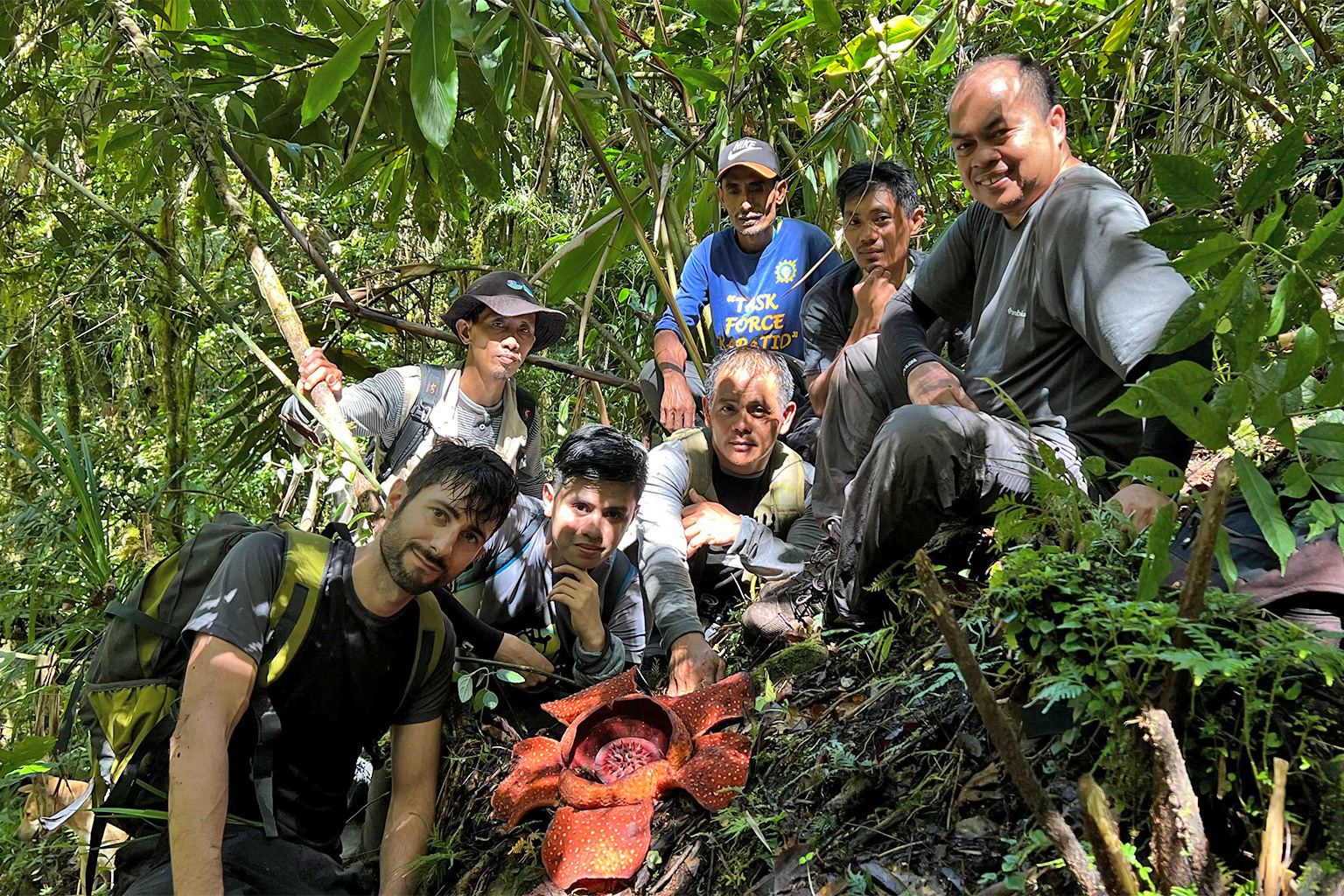- Rafflesia, flowering parasitic plants found only in Southeast Asian rainforests, are infamously difficult to study due to their rarity and small habitat ranges.
- With Rafflesia species edging closer to extinction due to habitat loss, botanists are working to better understand the genus and to develop methods that allow the plants to be propagated in labs and botanical gardens.
- Parallel research efforts from two teams led by Filipino scientists are yielding promising results in both understanding how Rafflesia function at the genetic level and in refining methods that will allow for ex situ cultivation.
Found only in Southeast Asian rainforests, the Rafflesia genus produces the world’s largest flowers. Their prodigious size is no small feat, considering that Rafflesia possess neither roots, leaves nor stems. They are also incapable of photosynthesis, relying entirely on their hosts (certain species of Tetrastigma vines) for nourishment.
These parasitic plants remain one of botany’s biggest mysteries. The gaps in knowledge about Rafflesia have created a considerable challenge for conservationists scrambling to save them, particularly in the Philippines, which scientists consider to be one of the few centers of Rafflesia diversity.
Threats to Rafflesia conservation in the Philippines
Due to their rarity and extremely small habitat range, Rafflesia are infamously difficult to study.
Experts have failed to grow Rafflesia plants ex situ outside of their host vines, says Erika Marie Bascos of the University of the Philippines Diliman’s Institute of Biology. “Unlike nonparasitic plants, Rafflesia cannot be readily propagated via cuttings, seeds or tissue culture,” she told Mongabay, adding that Rafflesia have only been successfully propagated by grafting infected vines or implanting seeds into uninfected hosts, methods that take a very long time to yield results.

Meanwhile, the clock is ticking, as all Rafflesia species are inching closer toward extinction.
Habitat destruction is a major threat, even in cases of small-scale land conversion. According to Esperanza Maribel Agoo, a professor from the Biology Department of De La Salle University in Manila, Rafflesia on private lands suffer habitat loss when owners convert their properties for commercial purposes.
Even Rafflesia-centric ecotourism has created risks for the plants’ conservation. “Because people are now aware that they can generate income from displaying these plants to the general public, they sometimes fight over which property should be seen first,” says Agoo, recalling a case of one family in Panay (part of the Visayas island group) who destroyed Rafflesia on another family’s land just to monopolize tourists’ attention.
Bascos also laments that ecotourism spots sometimes fail to incorporate scientists’ recommendations on exhibiting the plants without disturbing their natural environment and causing “more harm to the already scarce Rafflesia populations.”

Filling in the knowledge gaps about Rafflesia
Another threat to Rafflesia conservation is the general lack of information and awareness about the genus. “Rafflesia species are rare and restricted to remote forest habitats of Southeast Asia, so they are difficult to get to, collect and study,” evolutionary biologist Jeanmaire Molina, of New York’s Pace University, tells Mongabay.
In a recent study, Molina worked with scientists from the Philippines, the United States, Canada and Indonesia to assemble and study a transcriptome (a collection of gene transcripts) from the seeds of R. speciosa obtained from Miagao, Iloilo, in the Philippines.
By analyzing Rafflesia at the molecular level and comparing its transcriptome to certain flowering and parasitic plants, Molina and her colleagues found new information about the genetic and metabolic pathways of these mysterious plants. They identified specific compounds and enzymes that could improve the chances of successful seed inoculation. They also found no genes pointing to a symbiotic relationship between Rafflesia and fungi, suggesting that unlike orchids, Rafflesia may not need nutrients from fungi for successful germination.
“Studying biodiversity at the molecular level, particularly with a seed, would answer a lot of problems in propagation,” says Agoo, who is not affiliated with the study. “Molina’s lab provided the scientific basis for how Rafflesia exists and therefore how [conservation] can be done ex situ [outside its natural habitats].”


Local Rafflesia ex situ propagation
Meanwhile, a team of conservationists at the University of the Philippines Los Baños is taking a more straightforward approach. Pastor Malabrigo from the university’s Department of Forest Biological Sciences was part of a team that visited Indonesia’s Bogor Botanical Garden in November 2022, along with teaching associate Adriane Tobias and Chris Thorogood from Oxford University. There, he says, they studied methods Bogor employed to successfully propagate R. patma ex situ. “Our Indonesian colleagues have experimented with various techniques to grow R. patma for more than two decades,” Tobias tells Mongabay. During their trip, Malabrigo’s group carefully studied the grafting methods the Bogor researchers used; upon their return to the Philippines, they immediately set to work.
Malabrigo’s team opted to use vines infected with R. panchoana from Mount Makiling in Luzon, close to the grafting site at the UP Laguna Land Grant. For successful grafts, Malabrigo says, “it should not take more than 24 hours to transport [the infected vine] from the source.” While some Rafflesia take up to six years to bloom, R. panchoana’s reproduction cycle should allow results in just two years.
Bascos says she believes that if Malabrigo’s team succeeds, they could help potential researchers overcome the challenges of collecting samples and transporting them to the laboratory, the difficulty of conducting in situ studies and the danger of conducting research in areas where the Philippine military conducts anti-insurgency operations. “The prospect of growing and being able to study Rafflesia in botanical gardens could really help boost Rafflesia research in the country,” Bascos says.
“One approach to Rafflesia propagation is producing scientific evidence, while the other is just simply doing it,” Agoo says. “Both being done in parallel is a good thing.”

All hands on deck
Ultimately, successful Rafflesia conservation in the Philippines depends not just on research and action from the scientific community but also on the commitment and involvement of policymakers and ordinary citizens.
“We have to sustain the interest of the local people themselves,” stresses Agoo. “Not us who are away from the place, who can do experiments in our laboratories.”
“This kind of knowledge, when laymanized and shared with the general public and government agencies, would surely bring about better policies,” Bascos says. “And, hopefully, more attention and appreciation for this extraordinary species.”
Banner image: The Rafflesia possess neither roots, leaves nor stems. Image by Aqil F via Wikimedia Commons (CC BY-SA 4.0).
Illegal plant trade, tourism threaten new Philippine flowering herbs
Citations:
Bascos, E. M. A., Rodriguez, L. J. V., Duya, M. V., Fernando, E. S., & Ong, P. S. (2019). Philippine Rafflesia: Emerging patterns in floral morphology and distribution. Flora, 257, 151409. doi:10.1016/j.flora.2019.05.008
Molina, J., Wicaksono, A., Michael, T. P., Kwak, S., Pedales, R. D., Joly‐Lopez, Z., … Purugganan, M. D. (2023). The seed transcriptome of Rafflesia reveals horizontal gene transfer and convergent evolution: Implications for conserving the world’s largest flower. PLANTS, PEOPLE, PLANET. doi:10.1002/ppp3.10370
Jąkalski, M., Minasiewicz, J., Caius, J., May, M., Selosse, M., & Delannoy, E. (2021). The Genomic impact of Mycoheterotrophy in orchids. Frontiers in Plant Science, 12. doi:10.3389/fpls.2021.632033
